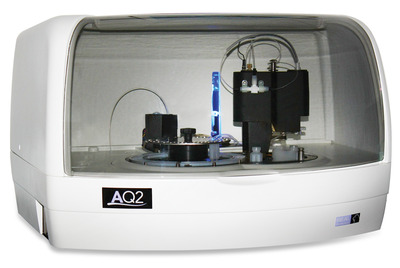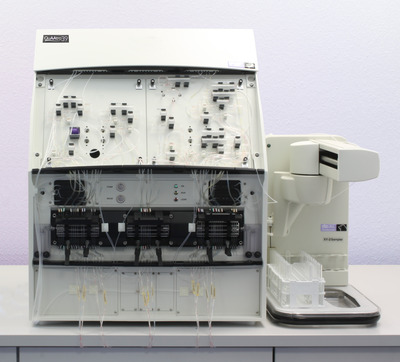Discrete or continuous flow analysis - which is better?
Tuesday, 04 February, 2014
With both discrete and continuous segmented flow analysers being widely available, choosing the better technique is one of the common decisions facing laboratory managers.
A wide variety of factors affects the choice of analytical instrument - target workload (samples/hour), variety of chemistries, methods required, bench space, staff availability etc. Both discrete and continuous flow systems offer fast, automated, colorimetric analysis of multiple samples, so the answer really depends on the current and future analytical requirements of the laboratory.
Discrete analysers employ sample trays and discrete reaction wells in which the colorimetric reaction takes place. In contrast, segmented flow analysers (SFA) employ a continuous flow of samples and reagent, segregated by air bubbles within tubing and mixing coils.
In general terms, discrete analysers are ideal when automation is a priority and/or when many and varied tests are needed on different samples. SFA is ideal when a larger number of samples is to be analysed for a smaller number of chemistries. However, both techniques are flexible, so it is important that expert advice is sought in the choice of analyser and that the instrument is configured to meet the precise needs of the laboratory.
Discrete analysers
In order to minimise operator involvement, most discrete analysers are highly automated and simple to set up and run, even overnight. A robotic sampling arm works in conjunction with a stepper motor-driven syringe that is responsible for aspirating, dispensing and mixing accurate and precise quantities of sample and reagent. For example, the SEAL AQ1 and AQ2 discrete analysers can run seven different chemistries from each sample in the same run - and another seven in another run. These instruments have three separate wash stations including a probe washer, so cross-contamination is not a problem. This washing feature means that even ammonia (using phenate), nitrate by cadmium reduction (using ammonium chloride buffer) and low-level phenol can be run together with no issues.
SEAL has also built an auto-dilution feature into the discrete analysers for preparing standards automatically and handling over-range samples. These diluted sample results are automatically bracketed by QC sets.

The reproducibility and detection limits of discrete analysers can be optimised by ensuring that each sample is read in the same optical glass cuvette with a 10 mm pathlength. The sample is always read in the same position in front of the detector, which eliminates any potential issues with scratching or reaction well variability that can be found with direct-read systems. Since the liquid is moved and not the tray, fewer moving parts maximises reliability.
Most discrete analysers employ miniaturised components to reduce reagent consumption and waste costs - 20 to 400 µL of reagent per sample is achievable.
Segmented flow autoanalysers
Based on the original tried and tested technology of the Technicon/Bran Luebbe AutoAnalyser, today’s SFAs deliver fast, accurate analysis for enormous numbers of samples; SEAL’s QuAAtro, for example, can run up to 600 tests/hour. SFAs are also highly automated and once the analyser is configured and the reagents and samples are loaded, reliable unattended operation is a major benefit.

A basic SFA system consists of an autosampler, a peristaltic pump, a chemistry manifold, a detector and AACE data acquisition software. Sample and reagents are pumped continuously through the chemistry manifold and air bubbles are introduced at precisely defined intervals, forming unique reaction segments which are mixed using glass coils. With SFA, even slow reactions run to completion and the ratio of sample to reagents in the detector reaches a constant maximum value; the steady-state condition.
SFAs have been developed for running a few parameters on a larger number of samples. Systems are in use by marine and seawater organisations and others running very low nutrient waters and by tobacco, soil and fertiliser industries around the world. These analysers provide maximum sensitivity by ensuring that the reaction always goes to completion, and with a digital true dual-beam detection system with real-time referencing, the highest reproducibility and very lowest detection limits are achieved.
In summary, when choosing the most appropriate analytical technique, it is important to consider both the current and likely future needs of the laboratory. In truth, the answer to the question: “Which technique is better?” is: “It depends …”
Novel activity identified for an existing drug
Drug discovery company Re-Pharm has used computational chemistry suite Forge, a product of its...
New structural variant of carbon made of pentagons
Researchers from the US and China have discovered a structural variant of carbon called...
Cosmic radio waves caught in real time
Swinburne University of Technology PhD student Emily Petroff has become the first person to...




